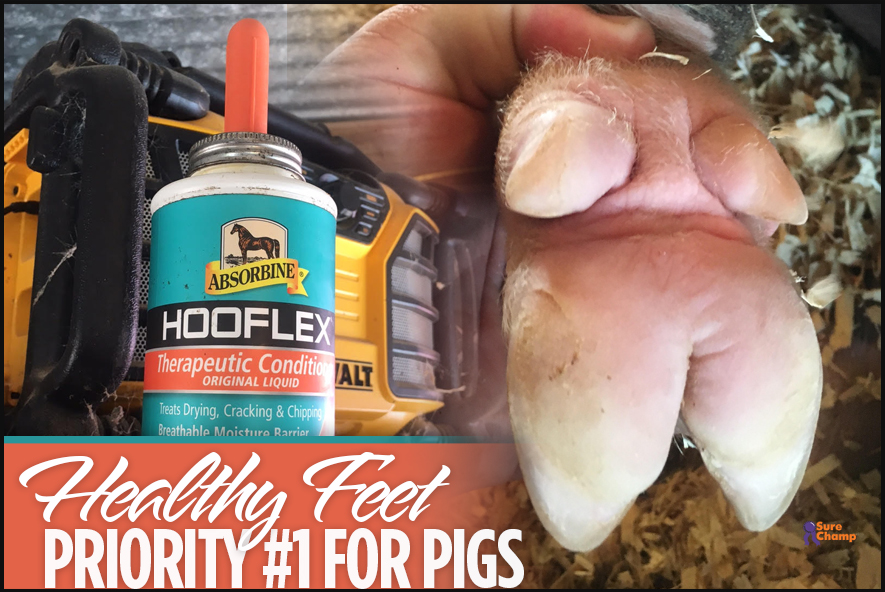
by Josh Brockman, Brockman Farms
If you’ve hung around a show ring or spent anytime in livestock judging camps, clinics or contests, you’ve probably heard some of the following terms: “comfort,” “athletic,” “sure footed,” “when you judge them from the ground up,” the list could go on and on. To get down to it, most of these speak to a pig’s ability to drive comfortably and correctly.
Structure, joints and general build are the most important factors in this all coming together. Evaluation emphasis on structure should be one of your main priorities when selection time comes. However, after the selection is done and your project is on feed, there are many other steps you can take help your pigs stay comfortable and lead to success in the show ring.
A huge priority to focus on is general health of your pigs’ feet, toes and pads throughout the feeding period. After many years of experience, I have a few tips and practices that we use to help ensure our pigs’ foundation is healthy through the growing season and all the way up to the show.

Facilities
One of the most basic factors is being sure you have a “sound” surface to grow your pigs on, and you maintain that surface through the year. Most of you feed on either concrete or dirt (sand) pens, and either one works. In concrete pens, we must use quality wood shavings to bed the pigs on to supply more cushion because bare concrete is obviously rougher on their pads.
Be sure you always have dry, clean bedding in the majority of the pen at a level where you cannot see the concrete surface below them. This will ensure your pig is walking on a cushioned surface versus bare, rough concrete. Another option is to lay rubber mats on top of the concrete as barrows or gilts get heavier later in the year. This will also help with not scarring pads. I only prefer this later in the year, due to the fact that young pigs can benefit from the natural filing on their toes from the concrete, preventing their toes from becoming too long.
When dealing with dirt or sand surfaces, the biggest concern is to be sure and keep the moisture level of your pigs feet balanced and healthy. In these pens, your pigs will naturally keep more moisture to their feet, and that’s a positive for building a healthy pad. At the same time, we must manage dirt pens closely to be sure our pen stays dry. A pig’s pad that is constantly exposed to excessive moisture from a wet dirt pen will cause the pad to soften and become more timid when walking on a harder like concrete or asphalt at the show.
Things to Watch & Manage
When it comes to feet management, the two main things to manage are toe length and evenness, and general pad healthiness. In the early part of the feeding phase (generally the first half), pigs do a majority of their development as far as joints and skeleton. In order for everything to grow correctly, I place a large emphasis in making sure their toes are square and even. Most of the time, this will take care of itself, especially if you have concrete pens because pigs will have a “natural” wear that keep their toes trimmed. However, sometimes there are cases where they wear the toes shorter on the inside or outside, and their toes become uneven, which causes their joints to have added pressure. This is much the same way a person wearing down one side of the sole of their shoe or boot. If this happens, I would consult with your veterinarian or breeder to find discuss trimming their feet.
The other major part of feet management is managing the pad of the pigs’ feet, especially later in the year. The pad is considered the area directly under the toe, and is the part of the foot that sets down on the surface. This part of the foot is very similar to the bottom of a person’s foot. It’s a different texture of skin from the rest of the body, designed to support and comfort to the remainder of the skeleton. A pig’s pad should be healthy and smooth, without cuts, tears or bruises. However, there will be cases when you will come across these issues as a pig continues to grow and develop.
For this, I recommend applying a quality hoof conditioner to their pad and toes daily from about 200 pounds all the way up to the show as a preventative and/or treatment. A hoof conditioner is very useful in balancing the moisture levels of the pad, as well as helping prevent or repair any cuts, cracks or tears that may develop. When looking for correct hoof conditioners, there are many great products on the market. Be sure when selecting a hoof conditioner to check the ingredients and label for any prohibited ingredients that could get you disqualified at the show. If you are unsure of these, talk with your veterinarian prior to use to be sure you’re covered and not breaking any rules. There are also times where you’ll find a torn pad with dead skin that is hanging and still partially attached to the pad. In these instances I always recommend clipping the dead skin down even to the pad to prevent a larger tear from forming.
Foot care is one small part of the daily management tasks of your swine project. To ensure the rest of your pig is functioning at their full potential on show day they must have a healthy foundation to do it on.

